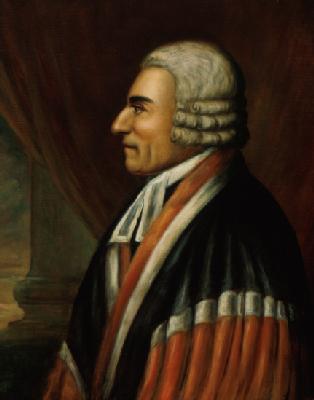- William Cushing
:"For the U.S. Navy hero, see
William B. Cushing ."Infobox Judge
name = William Cushing

imagesize =
caption =
office = Associate Justice of the United States Supreme Court
termstart =February 2 1790
termend =September 13 1810
nominator =George Washington
appointer =
predecessor = "(none)"
successor =Joseph Story
office2 =
termstart2 =
termend2 =
nominator2 =
appointer2 =
predecessor2 =
successor2 =
birthdate = birth date|1732|3|1|mf=y
birthplace =Scituate, Massachusetts , U.S.
deathdate = death date and age|1810|9|13|1732|3|1|mf=y
deathplace =Scituate, Massachusetts , U.S.
spouse =William Cushing (
March 1 ,1732 –September 13 ,1810 ) was an earlyassociate justice of theUnited States Supreme Court, from its inception to his death.Youth and early career
Born in Scituate
Massachusetts to a family which had settled in adjacent Hingham in 1638, Cushing became a member of the bar in Boston in 1751. (Cushing's family was among the earliest settlers of nearby Hingham, from which Scituate was carved.) Although his family had a history ofattorney ship, he seemed to have had a hard time at the beginning of his career. During that time, as well, his father,John Cushing , served on the Massachusetts Superior Court of Judicature for about 24 years. When his father resigned in 1771, Cushing took his position on the Court. However, when theAmerican Revolution started, he had to choose between the rebels and Great Britain; unlike the rest of the court, he chose the U.S.His work with state and federal constitutions
In 1783, Cushing presided over a criminal action that virtually abolished slavery in Massachusetts, citing the 1780 Constitution of Massachusetts's statement that "all men are born free and equal". During
Shays' Rebellion , he made sure that court sessions continued, even at the aggressive protests of the armed rebels. He later presided over the trial against the rebels. A year later, in 1788, he was vice president of the Convention of the Commonwealth of Massachusetts, which narrowly ratified the Constitution.Washington's first appointee
When
George Washington becamePresident of the United States , his first appointee to the Supreme Court was Cushing. Although he served on the Court for 21 years, only 19 of his decisions appear in the case reporters, mainly due to frequent travels and failing health, as well as the incompleteness of the case reports of the era. He generally held a nationalist or Federalist view, often disagreeing with Thomas Jefferson's Democratic-Republicans. His two most important decisions were probably "Chisholm v. Georgia " and "Ware v. Hylton ", which regarded intrastate suits and the supremacy of treaties.He administered the oath of office at Washington's second inauguration as president.
Cushing was probably the last American jurist to wear a wig. He died in 1810.
The third Chief Justice?
When
John Jay resigned from the Court in 1795, Washington was faced with the task of appointing a new Chief Justice. His first choice wasJohn Rutledge , but the Senate refused to confirm him (Rutledge still served as Chief Justice, however, byrecess appointment ). Washington subsequently nominated Cushing onJanuary 26 ,1796 ; the Senate unanimously confirmed the nomination the following day, whereupon Washington then signed and dispatched Cushing's commission. Remarkably, although Cushing likely was present inPhiladelphia —the temporary capital—during these events,Fact|date=May 2008 he was unaware of the nomination (likely due to the secretiveness of the Senate at the time) until Washington introduced him as "Chief Justice" at a dinner party.Cushing received his commission and on
February 3 and 4 appears to have sat as Chief Justice during that session. The rough minutes of the Court for those dates list him as Chief Justice, although this entry was later crossed out. This error can be explained by the text of theJudiciary Act of 1789 , which allowed for the Court to hear cases with a quorum of only four justices; i.e. the Chief Justice need not be present for the Court to conduct business. As Cushing was the most senior Associate Justice present at the time, he would have been expected to preside over the proceedings.On
February 5 , Cushing returned the commission to Washington with a letter referring to his "infirm & declining state of health." Washington then nominatedOliver Ellsworth to be Chief Justice, transmitting the nomination to the Senate in a message saying that the nominee would replace "William Cushing, "resigned"." Subsequent histories of the Court have not counted Cushing as a Chief Justice, but instead report that he declined the appointment. The latter explanation is more logical in that if Cushing had accepted the Office of Chief Justice and then resigned, he would have had to leave the Court entirely, since accepting the Chief Justice seat would implicitly require him to resign his place as an Associate Justice. The fact that he continued on the Court as an associate justice for years afterward lends more weight to the assertion that Cushing declined.References
*
Tony Mauro : [http://www.law.com/jsp/article.jsp?id=1127207113073 "The Chief Justice Who Wasn't There",]Legal Times (September 19, 2005)
*Ross E. Davies: "William Cushing, Chief Justice of the United States", [http://ssrn.com/abstract=896184 [University of Toledo Law Review, Vol. 37, No. 3, Spring 2006]External links
* [http://www.michaelariens.com/ConLaw/justices/cushing.htm William Cushing Biography]
* [http://www.oyez.org/oyez/resource/legal_entity/3/biography Another Biography]
Wikimedia Foundation. 2010.
